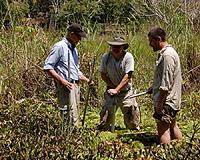 |
Washington DC (SPX) Mar 30, 2011 Recent climate modeling has shown that reducing the concentration of carbon dioxide in the atmosphere would give the Earth a wetter climate in the short term. New research from Carnegie Global Ecology scientists Long Cao and Ken Caldeira offers a novel explanation for why climates are wetter when atmospheric carbon dioxide (CO2) concentrations are decreasing. Their findings, published online by Geophysical Research Letters, show that cutting carbon dioxide concentrations could help prevent droughts caused by global warming. Cao and Caldeira's new work shows that this precipitation increase is due to the heat-trapping property of the greenhouse gas carbon dioxide in the atmosphere. Carbon dioxide traps heat in the middle of the atmosphere. This warm air higher in the atmosphere tends to prevent the rising air motions that create thunderstorms and rainfall. As a result, an increase in the atmospheric concentration of carbon dioxide tends to suppress precipitation. Similarly, a decrease in the atmospheric concentration of carbon dioxide tends to increase precipitation. The results of this study show that cutting the concentration of precipitation-suppressing carbon dioxide in the atmosphere would increase global precipitation. This is important because scientists are concerned that unchecked global warming could cause already dry areas to get drier. (Global warming may also cause wet areas to get wetter.) Cao and Caldeira's findings indicate that reducing atmospheric carbon dioxide could prevent droughts caused by climate change. "This study shows that the climate is going to be drier on the way up and wetter on the way down," Caldeira said, adding:"Proposals to cool the earth using geo-engineering tools to reflect sunlight back to space would not cause a similar pulse of wetness." The team's work shows that carbon dioxide rapidly affects the structure of the atmosphere, causing quick changes precipitation, as well as many other aspects of Earth's climate, well before the greenhouse gas noticeably affects temperature. These results have important implications for understanding the effects of climate change caused by carbon dioxide, as well as the potential effects of reducing atmospheric carbon dioxide concentrations. "The direct effects of carbon dioxide on precipitation take place quickly," said Cao. "If we could cut carbon dioxide concentrations now, we would see precipitation increase within the year, but it would take many decades for climate to cool."
Share This Article With Planet Earth
Related Links Carnegie Institution Climate Science News - Modeling, Mitigation Adaptation
 UC Research Explores Why Ancient Civilization Was Living On The Edge
UC Research Explores Why Ancient Civilization Was Living On The EdgeCincinnati OH (SPX) Mar 30, 2011 University of Cincinnati research is investigating why a highly sophisticated civilization decided to build large, bustling cities next to what is essentially swampland. The research by UC Geography Professor Nicholas Dunning, a three-year, interdisciplinary project including David Lentz, professor of biological sciences, and Vern Scarborough, professor of anthropology, will be presented April 1 ... read more |
|
| The content herein, unless otherwise known to be public domain, are Copyright 1995-2010 - SpaceDaily. AFP and UPI Wire Stories are copyright Agence France-Presse and United Press International. ESA Portal Reports are copyright European Space Agency. All NASA sourced material is public domain. Additional copyrights may apply in whole or part to other bona fide parties. Advertising does not imply endorsement,agreement or approval of any opinions, statements or information provided by SpaceDaily on any Web page published or hosted by SpaceDaily. Privacy Statement |